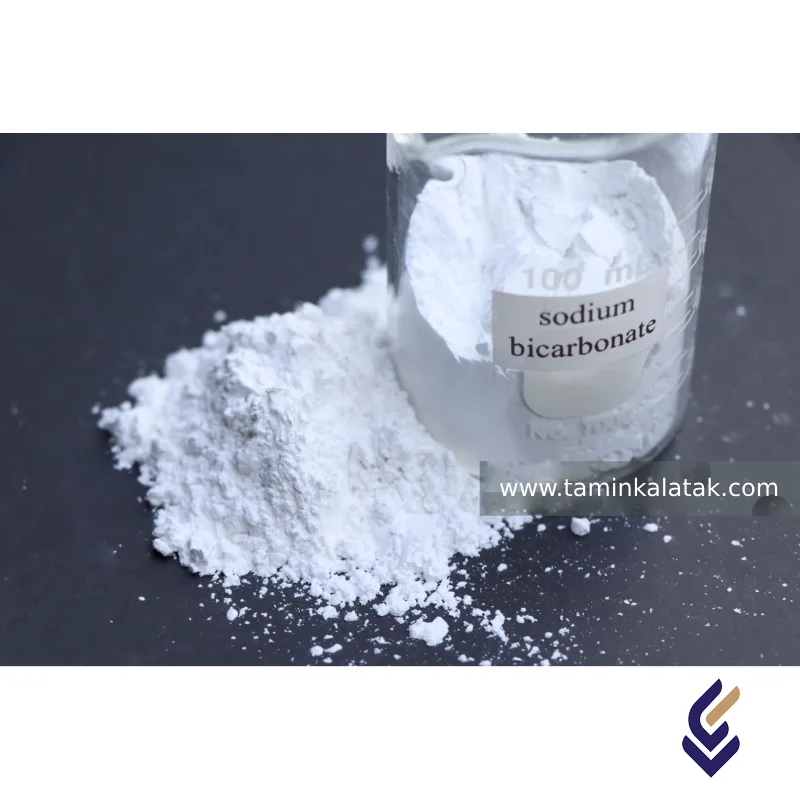Sodium Bicarbonate
Sodium Bicarbonate, also known as Baking Soda, Sodium Hydrogen Carbonate, or NaHCO₃, is a white, odorless, crystalline, and mildly hygroscopic inorganic compound. It has a wide range of applications in the food, pharmaceutical, cosmetic, agricultural, detergent, petrochemical, firefighting, and water treatment industries. It functions as a pH regulator, buffering agent, antacid, mild cleanser, flame retardant, and deodorizing agent.
Chemical Structure of Sodium Bicarbonate
-
Chemical Formula: NaHCO₃
-
IUPAC Name: Sodium Hydrogen Carbonate
-
Molecular Structure: Ionic (Na⁺ + HCO₃⁻)
-
CAS Number: 144-55-8
-
3D Structure: The hydrogen carbonate ion (HCO₃⁻) is planar and forms a stable ionic crystal lattice with sodium ions in the solid state.
-
Molecular Weight: 84.01 g/mol
-
Natural Source: Found naturally in deposits such as Nahcolite.
Physical and Chemical Properties
| Property | Description |
|---|---|
| Physical State | White crystalline or powdery solid |
| Taste and Odor | Odorless, slightly alkaline taste |
| Decomposition Temperature | Approximately 270 °C |
| pH (1% aqueous solution) | Between 8.2 and 8.6 |
| Viscosity | Not applicable (solid material) |
| Chemical Stability | Stable under normal conditions; decomposes upon heating to CO₂, Na₂CO₃, and H₂O |
Applications of Sodium Bicarbonate
Food Industry (Food Grade – E500)
-
Leavening agent in bread, cakes, and baked goods
-
pH regulator in processed foods
-
Antacid component in carbonated drinks and instant beverage powders
Pharmaceutical Industry
-
Antacid for treatment of heartburn and acid reflux
-
Active ingredient in mouthwash, nasal rinse, and contact lens solutions
-
Buffering agent in effervescent tablets, injectables, and syrups
Detergent and Cleaning Industry
-
Mild cleaning and natural deodorizing agent
-
Water softener in detergent powders
-
Odor absorber in refrigerators and footwear
Firefighting
-
Primary component of dry chemical fire extinguishers
-
Neutralizing agent for acid spills in chemical emergencies
Agriculture and Animal Husbandry
-
Soil pH balancer for acidic soils
-
pH regulator in animal feed formulations
-
Antifungal treatment for plant leaves
Water and Wastewater Treatment
-
pH adjustment in industrial effluents
-
Neutralization of dissolved metal ions
Advantages of Sodium Bicarbonate
-
Non-toxic, biocompatible, and environmentally degradable
-
Available in food, pharmaceutical, and industrial grades
-
Safe for humans and the environment under permitted doses
-
Multi-functional and cost-effective
-
Chemically stable during long-term storage under proper conditions
-
Compatible with many other chemical substances
Disadvantages of Sodium Bicarbonate
-
Moisture-sensitive – loses effectiveness in humid environments
-
Decomposes at high temperatures, unsuitable for direct thermal processes
-
Excessive use may cause over-alkalization of the medium
-
Requires high purity grades for specific uses (e.g., pharmaceutical, food)
-
Not suitable for closed pressurized systems due to CO₂ generation during decomposition
Safety and Handling
-
GHS Classification: Not classified as hazardous
-
Oral Toxicity: Non-toxic at dietary levels (GRAS – Generally Recognized as Safe by FDA)
-
Inhalation: Low hazard; excessive dust exposure may irritate respiratory passages
-
Skin and Eye Contact: Generally safe; prolonged exposure may cause dryness of skin
-
Reactivity: Stable; decomposes upon heating to form Na₂CO₃, CO₂, and H₂O
Safety Precautions
-
Use a respiratory mask in dusty industrial environments
-
Wear protective gloves when handling large quantities
-
Use safety goggles in powder-handling areas
-
Ensure adequate ventilation in storage or enclosed spaces
-
Avoid direct contact with acids (reacts vigorously with effervescence)
Storage Conditions
| Parameter | Recommended Condition |
|---|---|
| Storage Temperature | Between 15 °C and 30 °C |
| Humidity | Dry, low-humidity environment (moisture causes caking) |
| Light Exposure | Store away from direct sunlight |
| Packaging | Multi-layer polypropylene or kraft paper bags with moisture barrier |
| Storage Area | Covered, ventilated warehouse away from acids |
| Labeling | Clear and standardized labeling (production date, grade, safety warnings, storage conditions) |
Applications
| Applications | , , , |
|---|
Sodium Bicarbonate
| Products | Chemical formula | Grade | Solubility in water | Melting point | Density (at 20°C) | Physical appearance | Vapor pressure |
|---|---|---|---|---|---|---|---|
| Sodium Bicarbonate Sodium Hydrogen Carbonate | NaHCO₃ | Food grade, Pharmaceutical grade, Industrial grade | 96 g/L (or 9.6 g/100 mL) – slightly alkaline solution with a pH of about 8.3 | It starts to decompose at around 50°C (no melting point – thermal decomposition) | 2.159 g/cm³ | White powder or crystals, odorless | Practically none |







